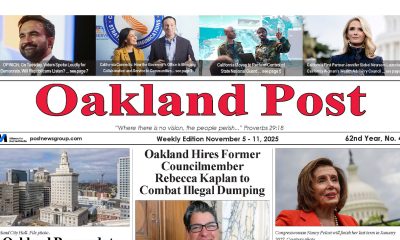Op-Ed
Beyond the Rhetoric: How the Army Addressed Racial Tensions
By Harry C. Alford
NNPA Columnist
I remember sitting through a lecture in a sociology class during my senior year at the University of Wisconsin. The professor was boring and I had a newspaper. I looked at the front page and noticed a list of dates. They were birth dates for the new Army draft lottery. Most exemptions from the draft were gone and President Richard M. Nixon implemented the draft lottery based on birth dates. There it was, my birth date – Feb. 14 – listed as the fourth number to go. Those with the first 100 birth dates were going to get drafted into the Army and I was near the top of the list. My first thoughts: “My future is toast. ”I am going to go to Vietnam and catch a bullet or grenade. If I survive, I am not going to live on a college salary but a drafted private in poverty.”
Procter & Gamble had already made me a job offer. My fear was that my draft status was going to kill the employment opportunity, if not me. However, my corporate recruiter told me not to worry. In fact, he said that what I presented to them was an opportunity. I could go into the Army and come out an officer. That would give me a “triple.” I would be college degreed plus a competitive athlete via football as well as a military officer. He showed me how to apply for Officer Candidate School and I was soon accepted. Thus, I worked a few months before it was time to get inducted and then off to Officer Candidate School in Ft. Benning, Ga.
The racial tension that soared immediately after the assassination of Dr. Martin Luther King Jr. in 1968 was starting to carry over into the Army. That would make sense as they were drafting young men at a rapid pace and Blacks would be over-represented in the demographics, especially among junior ranking soldiers. Blacks and Hispanics had no slick attorneys to help them avoid service like so many White young men. Fights, threats and even murder were starting to appear in the ranks, especially in Vietnam. You can’t have an efficient fighting military when the soldiers are fighting among themselves.
The Army was a snap for me. My football conditioning came in handy and compared to many of the draftees, my charisma was glowing. If it weren’t for wars, I would have stayed forever. A few months after I finished OCS and Finance School, I was assigned to Dugway Proving Grounds, Utah, 70 miles southwest of Salt Lake City. Three months into my new assignment, I was appointed the Race Relations Officer. The Pentagon decided to aggressively address the racial problems it was having in the field. Each brigade would have an active Race Relations Officer who would report to the Commanding Officer on a regular basis and would also directly report to the Pentagon any serious and negative activity. I spent three weeks at the new Race Relations Training School in Ft. Benning. More than 90 percent of the Race Relations Officers were Black.
We would get together three times a year and compare our experiences: –what worked well and what didn’t. A formal summary would be crafted for review by the Pentagon. I would now counsel personnel who had complaints or suspicions. I would write columns on Black history and self-esteem in the local newspaper. Many White soldiers would come to me and say things like, “I didn’t know coloreds did that.” Just the fact that it was well known that we had a Race Relations Officer who was accessible 24/7 made things a lot better.
Whites, especially southern Whites, started to enjoy a new comfort level. At my post, we had a majority of Mormons who were trying to change their image. The denomination they barred Blacks from joining their church until the mid-1970’s. The change was sincere and our military was better because of this program.
There was one personal “hiccup.” I received a call from our contact at the Pentagon. The colonel asked me to explain why a cross burning was considered a minor act on my watch. I replied that it wasn’t. He said, “I am sending this report to you and want an explanation.”
The Commanding Officer had executed his own report and sent it in as if it were from me. I asked him for an explanation since the eyes of the Pentagon were upon us. He broke clean. Someone put a 4’ cross in a Black sergeant’s yard. The military police caught the culprit. He was the child of the post’s Executive Officer, the second-highest ranking officer in command. The Commanding Officer was embarrassed, so they kept the identity of the perpetrator secret and asked the Black sergeant to be quiet about it for the sake of peace – and he did. The Pentagon accepted the final version.
This Army-wide program succeeded and the main reason is that we owned up to the problem and sat down with each other to just “get along” as Rodney King would later admonish the public.
Harry C. Alford is the co-founder, President/CEO of the National Black Chamber of Commerce®. Website:www.nationalbcc.org Email: halford@nationalbcc.org.
###
Alameda County
Seth Curry Makes Impressive Debut with the Golden State Warriors
Seth looked comfortable in his new uniform, seamlessly fitting into the Warriors’ offensive and defensive system. He finished the night with an impressive 14 points, becoming one of the team’s top scorers for the game. Seth’s points came in a variety of ways – floaters, spot-up three-pointers, mid-range jumpers, and a handful of aggressive drives that kept the Oklahoma City Thunder defense on its heels.

By Y’Anad Burrell
Tuesday night was anything but ordinary for fans in San Francisco as Seth Curry made his highly anticipated debut as a new member of the Golden State Warriors. Seth didn’t disappoint, delivering a performance that not only showcased his scoring ability but also demonstrated his added value to the team.
At 35, the 12-year NBA veteran on Monday signed a contract to play with the Warriors for the rest of the season.
Seth looked comfortable in his new uniform, seamlessly fitting into the Warriors’ offensive and defensive system. He finished the night with an impressive 14 points, becoming one of the team’s top scorers for the game. Seth’s points came in a variety of ways – floaters, spot-up three-pointers, mid-range jumpers, and a handful of aggressive drives that kept the Oklahoma City Thunder defense on its heels.
One of the most memorable moments of the evening came before Seth even scored his first points. As he checked into the game, the Chase Center erupted into applause, with fans rising to their feet to give the newest Warrior a standing ovation.
The crowd’s reaction was a testament not only to Seth’s reputation as a sharpshooter but also to the excitement he brings to the Warriors. It was clear that fans quickly embraced Seth as one of their own, eager to see what he could bring to the team’s championship aspirations.
Warriors’ superstar Steph Curry – Seth’s brother – did not play due to an injury. One could only imagine what it would be like if the Curry brothers were on the court together. Magic in the making.
Seth’s debut proved to be a turning point for the Warriors. Not only did he contribute on the scoreboard, but he also brought a sense of confidence and composure to the floor.
While their loss last night, OKC 124 – GSW 112, Seth’s impact was a game-changer and there’s more yet to come. Beyond statistics, it was clear that Seth’s presence elevated the team’s performance, giving the Warriors a new force as they look to make a deep playoff run.
Activism
Essay: Intentional Self Care and Community Connections Can Improve Our Wellbeing
At the deepest and also most expansive level of reality, we are all part of the same being, our bodies made from the minerals of the earth, our spirits infused by the spiritual breath that animates the universe. Willingness to move more deeply into fear and pain is the first step toward moving into a larger consciousness. Willingness to move beyond the delusion of our separateness can show us new ways of working and living together.

By Dr. Lorraine Bonner, Special to California Black Media Partners
I went to a medical school that was steeped in the principles of classical Western medicine. However, I also learned mindfulness meditation during that time, which opened me to the multifaceted relationship between illnesses and the interconnecting environmental, mental and emotional realities that can impact an individual’s health.
Therefore, when I began to practice medicine, I also pursued training in hypnosis, relaxation techniques, meditation, and guided imagery, to bring a mind-body focus to my work in medical care and prevention.
The people I saw in my practice had a mix of problems, including high blood pressure, diabetes, and a variety of pain issues. I taught almost everyone relaxation breathing and made some general relaxation tapes. To anyone willing, I offered guided imagery.
“My work embraced an approach to wellness I call “Liberatory Health” — one that not only addresses the treatment and management of disease symptoms but also seeks to dismantle the conditions that make people sick in the first place.”
From my perspective, illness is only the outermost manifestation of our efforts to cope, often fueled by addictions such as sugar, tobacco, or alcohol, shackled by an individualistic cult belief that we have only ourselves to blame for our suffering.
At the deepest and also most expansive level of reality, we are all part of the same being, our bodies made from the minerals of the earth, our spirits infused by the spiritual breath that animates the universe. Willingness to move more deeply into fear and pain is the first step toward moving into a larger consciousness. Willingness to move beyond the delusion of our separateness can show us new ways of working and living together.
To put these ideas into practical form, I would quote the immortal Mr. Rogers: “Find the helpers.” There are already people in every community working for liberation. Some of them are running for office, others are giving food to those who need it. Some are volunteering in schools, libraries or hospitals. Some are studying liberation movements, or are working in urban or community gardens, or learning to practice restorative and transformative justice, or creating liberation art, music, dance, theater or writing. Some are mentoring high schoolers or apprenticing young people in a trade. There are many places where compassionate humans are finding other humans and working together for a better world.
A more compassionate world is possible, one in which we will all enjoy better health. Creating it will make us healthier, too.
In community, we are strong. Recognizing denial and overcoming the fragmenting effects of spiritual disorder offer us a path to liberation and true health.
Good health and well-being are the collective rights of all people!
About the Author
Dr. Lorraine Bonner is a retired physician. She is also a sculptor who works in clay, exploring issues of trust, trustworthiness and exploitation, as well as visions of a better world.
Activism
Opinion: Can Donald Trump Pole Dance?
Given all that is happening, if the presidency was more like pole dancing, you know Trump would be flat on his butt.

By Emil Guillermo
The news cycle has been buzzing the last few weeks. Xi, with Putin and Kim, the sweethearts of Trump carousing alone without him? The victims of the pedophile Epstein speaking out publicly in DC.
Then, there’s the release of that salacious letter Donald Trump allegedly wrote to Jeffrey Epstein. Trump said the letter didn’t exist. But it does.
Timing is everything.
Additionally, there are further concerns, such as the Supreme Court removing restrictions on ICE interactions. ICE Agents can stop anyone now. For any reason. And there’s the threat of the U.S. sending the military to fight crime in Chicago. Trump even posted a meme of himself as a character in “Apocalypse Now.”
All that with bad polls and bad economic numbers, and these topics are dominating the news cycle — Trump era chaos.
Given all that is happening, if the presidency was more like pole dancing, you know Trump would be flat on his butt.
The reality is the opposite. He keeps going strong like nothing’s happened. Inexplicably, Trump always seems to defy gravity.
That’s why to reassure myself with reality, I just think of Trump on a pole. Dancing. He was born on Flag Day, after all.
I’ve got pole dancing on my mind because I’m in Canada at the Vancouver Fringe Festival doing my show, “Emil Amok 69, Everything’s Flipped,” about how the current political situation gets very personal.
Get tickets here if you’re near:
I’ve performed at 16 fringe festivals, and I always look for unique performers. This year, in my same venue (the Revue Stage) I found her in a show, “The Pole Shebang.”
Andrea James Lui may look like a typical Asian American at first.
But she’s Asian Canadian, married to an Australian, who now lives down under.
At the Vancouver Fringe, she highlights her special identity.
Pole Dancer
Yes, pole dancing has come to the fringe. Leave your dollar bills at home, this is not that kind of pole dancing.
This is more Cirque Du Soleil-ish- acrobatic stuff, yet it’s hard to deny the sexiness when a woman flawlessly swings from a pole with her legs apart.
The show is more intriguing than it is titillating.
Lui has created a behind-the-scenes look at the “polar” experience.
“She could have been a physicist,” says her big sister Christina, who despite saying that, supports her sister 100 percent.
Lui touches on some of the emotional depth in the poled subculture. But there’s plenty more to mine in the future. “Polar Bare,” the Musical? I’d see it.
Trump on a Pole
So that’s how I’ve come to the polar metaphor.
As Trump flails in the news, I picture him on a pole.
The letter to Epstein is further proof of the character of the man.
Will he stay afloat?
Not if the presidency were more like pole dancing.
You can’t lie on the pole.
That’s one way all of us in the Trump era can get to the truth.
About the Author
Emil Amok is a veteran journalist, commentator, and stage monologist. He has written a weekly column on Asian Americans for more than 30 years.
Contact: www.amok.com
-

 Activism3 weeks ago
Activism3 weeks agoOakland Post: Week of November 12 – 18, 2025
-

 Activism4 weeks ago
Activism4 weeks agoOakland Post: Week of November 5 – 11, 2025
-

 Activism2 weeks ago
Activism2 weeks agoIN MEMORIAM: William ‘Bill’ Patterson, 94
-

 Activism3 weeks ago
Activism3 weeks agoHow Charles R. Drew University Navigated More Than $20 Million in Fed Cuts – Still Prioritizing Students and Community Health
-

 Bay Area3 weeks ago
Bay Area3 weeks agoNo Justice in the Justice System
-

 #NNPA BlackPress3 weeks ago
#NNPA BlackPress3 weeks agoThe Perfumed Hand of Hypocrisy: Trump Hosted Former Terror Suspect While America Condemns a Muslim Mayor
-

 #NNPA BlackPress2 weeks ago
#NNPA BlackPress2 weeks agoTrump’s Death Threat Rhetoric Sends Nation into Crisis
-

 #NNPA BlackPress3 weeks ago
#NNPA BlackPress3 weeks agoProtecting Pedophiles: The GOP’s Warped Crusade Against Its Own Lies





























































